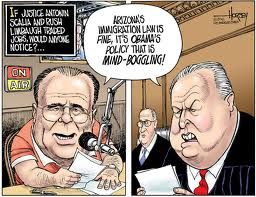Cross posted from The Stars Hollow Gazette
 In his dissenting opinion on the Arizona v. United States, Supreme Court Justice Antonin Scalia went on a politically motivated rant that was directed at President Obama’s directive that would allow 800,000 undocumented immigrants who are under 30 came here as children to legally remain in the US. Not only was Scalia’s partisan political rant an embarrassment for the Court, it was factually wrong and racist.
In his dissenting opinion on the Arizona v. United States, Supreme Court Justice Antonin Scalia went on a politically motivated rant that was directed at President Obama’s directive that would allow 800,000 undocumented immigrants who are under 30 came here as children to legally remain in the US. Not only was Scalia’s partisan political rant an embarrassment for the Court, it was factually wrong and racist.
First the facts that Scalia misrepresented and skewed. The Justice made this statement (pdf):
After this case was argued and while it was under consideration, the Secretary of Homeland Security announced a program exempting from immigration enforcement some 1.4 million illegal immigrants under the age of 30. If an individual unlawfully present in the United States
“• came to the United States under the age of sixteen;
“• has continuously resided in the United States for at least five years . . . ,
“• is currently in school, has graduated from high school, has obtained a general education development certificate, or is an honorably discharged veteran . . . ,
“• has not been convicted of a [serious crime]; and
“• is not above the age of thirty,” . . . .
The husbanding of scarce enforcement resources can hardly be the justification for this, since the considerable administrative cost of conducting as many as 1.4 million background checks, and ruling on the biennial requests for dispensation that the nonenforcement program envisions, will necessarily be deducted from immigration enforcement.
Part of the President’s reasoning for this order is the fact that congress has failed to provide the the $285 billion cost of deporting every illegal immigrant currently in the US and decided to use the limited resources available by focusing on undocumented immigrants who commit serious offenses and shifting resources away from college students and veterans. Scalia’s math is a bit off by some 600,000 more immigrants than is estimated to be affected by the President’s new policy.
Now to the really egregious racist spew that relied on racist Post Civil War laws that prohibited freed slaves from moving into Southern States:
Notwithstanding “[t]he myth of an era of unrestricted immigration” in the first 100 years of the Republic, the States enacted numerous laws restricting the immigration of certain classes of aliens, including convicted criminals, indigents, persons with contagious diseases, and (in Southern States) freed blacks. State laws not only provided for the removal of unwanted immigrants but also imposed penalties on unlawfully present aliens and those who aided their immigration
This is comes on the heels of Scalia’s defense of tortute, his dismissal of the execution of innocent people at the hands of the states and his homophobia and his inability to distinguish legal arguments from political talking points
Scalia doesn’t seem to care that in his dotage he is sounding increasingly unhinged and more and more like a right wing talk radio host. Even Chief Justice Roberts should be embarrassed by this racist bile. If Scalia can’t control himself, he should be removed from the Court, if he doesn’t have the good sense to remove himself into retirement.




